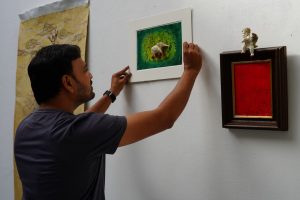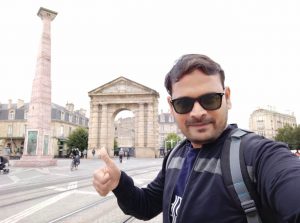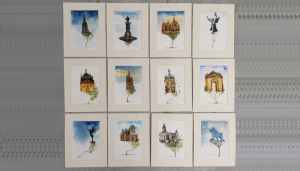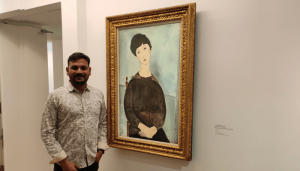Painter. Teacher. Researcher. In that order. Meet Sunil Lohar, faculty in charge of Painting at the Centre for Exact Humanities, IIITH. Back home from a fully sponsored 6-week artist residency programme at Bordeaux, France as part of a unique cultural exchange programme, he speaks of his experiences there, paintings inspired by what he saw and did not. Read on.
A cultural partnership was just one of the areas undertaken as a result of a five-year agreement signed between the Government of Telangana and the Bordeaux Metropole in 2015. Joint ventures between the two bodies were kicked off in other areas too such as urban policy, water and waste management, IT industry, aeronautical engineering, wine industry, academics, and tourism. Every year since then, as part of the cultural exchange, Bordeaux Metropole in association with Kalakriti Art Gallery, Hyderabad facilitates and organizes cross-artist residencies. In 2018, La Reserve-Bienvenue and BAM (an agency whose acronym stands for its founders Barbara Fecchio, Alice Cavender, and Marie Ladonne ) projects joined hands to facilitate the cultural exchange on behalf of Bordeaux Metropole. La Reserve-Bienvenue is a co-working area (a former pasta factory) that provides space, materials and the freedom to paint to visiting foreign artists. Sunil who has been associated with Kalakriti Art Gallery where he has been exhibiting his works over the last 10 years, was shortlisted and selected by La Reserve-Bienvenue and BAM.
Going With The Flow
“I’m a painter first and I’ve always had a love for water colours,” says Sunil. Despite dabbling in acrylics and other oil colours, he says that it’s the organic nature of the medium of water colours on paper that has him fascinated. Explaining the philosophy behind it, he says,”It’s like colour controlling the flow of water. Sometimes you control the flow of water, and other times, it controls you. This sort of a dialogue is really good. And many times, interesting things emerge accidentally.” It was to teach painting to the BTech students that he came to IIITH after a stint as an independent artist with a studio of his own. “Typically the students here are not from an art background. Teaching them art is not only challenging because they are often disinterested but also it is like an existentialist question! You have to prove why art is important in a technical institute like this and the role it plays,” he says. Sunil also conducts some elective courses and takes on independent study projects for 3rd and 4th year students. Understanding differences in experiencing the original work versus seeing it on a screen; how digitization affects aesthetic sensibilities, or understanding balance in popular images and so on, form part of independent studies.

As a researcher, Sunil’s focus is on the formal nature of Indian folk paintings. And he does this by keenly looking into the styles and icons of such art and gauging them in terms of their artistic value and aesthetic sensibilities. “My guide, the late Navjyoti Singh sir was of the opinion that practitioners of art can do better research since they know the nuances of making a painting,” he says. Drawing a parallel with a design problem, Sunil likens the painting process to an algorithm where an artist encounters problems, the manner in which it is solved and how an end is brought about to the painting itself.

Bienvenue to the Wine Capital
When Sunil Lohar took off to Bordeaux, he went with a blank slate. “My idea was to go without any preconceived notions or a plan.” He had also consciously decided not to paint what he had been doing in India all along, but to immerse himself in the cultural milieu of the elegant southwestern city of France. With this in mind, he undertook research to familiarize himself with the surroundings. From visiting museums (on art as well as wine) and libraries, to taking photographs, from chatting with the locals to drawing sketches, Sunil spent time to unearth local flavours and stories because he believes that stories reveal the real you. “Stories have seeds of truth in them. They reveal who you are, your culture, your beliefs, the idea of truth in your culture and so on.” The first painting that he undertook conveys his first impression of the world’s wine capital. It was a painting of a grape tree that supported all the iconic architectural buildings of Bordeaux. “The grapevine is a creeper that needs support to grow and is weak. The idea was to metaphorically convey that the entire economy of Bordeaux rests on this fragile creeper.”

Preserving History
Sunil’s research into the city’s past also unearthed a darker side to the glitz and glamour seen today. Several hundreds of years ago, Bordeaux was the second largest slave trading port in France. From the 17th to the 19th century, ships carrying slaves were sent to America. And in return the ships came back with cotton, tobacco, sugar, and rum, helping the city grow richer. Since the image of slavery is stark, Sunil however found that the city had consciously shied away from giving public space to the history it merited.“I started painting about those slaves just to show that beneath the gleam of Bordeaux, there exists a history of slavery. Having inherited a colonial past myself under the British, I felt connected with them. Through my paintings I want to suggest that history should not be obliterated but incorporated into the curriculum for the younger generations,” says Sunil. While researching, Sunil also discovered that most of France was occupied by the Germans during 1940-44 and Bordeaux was bombed by both the Allies and the Germans during World War II. But there are no memorials or any signages of a war having taken place. Attempts to engage with locals on it turned out to be futile with most of them visibly uncomfortable talking about the past. All this created an impression and over his 6-week stay, Sunil created around 28 watercolours in fine lines showcasing the prosperous city of Bordeaux with its iconic architecture, as well as his work on memory and the history of slavery there.
Sunil was also approached by a Professor from Bordeaux University to present on Indian art and aesthetics, which was very well received by the faculty and students alike.

Learning and Teaching: A Cycle
Terming the entire residency as a wholesome learning experience, Sunil says,”It gave me a lot of ideas and experiences which I can adopt here. I’m now a more learned person and I can teach better here.” Overwhelmed by the respect demonstrated towards art and artists in Europe, Sunil reveals that a percentage of the budget allocated to any infrastructural development in the city is set aside for installation of art works in Bordeaux. Hence, it was with great joy that he received news that plans are afoot to renovate a building and dedicate it to fine art on the IIITH campus. In fact, continuing on his theme of connecting with the past, Sunil hopes to create a little space on campus where IIITH’s memories can be preserved. “There are many turning points in IIITH’s journey. Those ought to be showcased somewhere, in an installation or a photograph. Did you know that rather than cutting it down, the big Jagruti (Banyan) tree was transplanted, roots et al when a road came up, to its current location? No one knows this story. There’s even a story behind the naming of each building – Himalaya, https://masterra.com/ and so on. It would be interesting to have all this documented.”

Art works produced during the cross-residency programme by Sunil Lohar (who visited Bordeaux) and the Bordeaux-based artist Emanuelle Leblanc (who visited Hyderabad) were on display at Kalakriti Art Gallery, Banjara Hills from 8 – 15 November 2019.



Next post